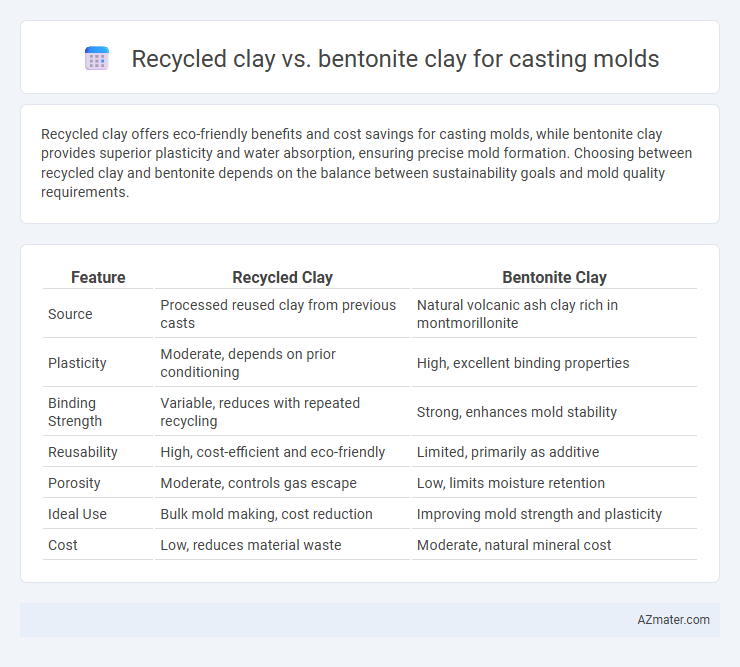Recycled clay offers eco-friendly benefits and cost savings for casting molds, while bentonite clay provides superior plasticity and water absorption, ensuring precise mold formation. Choosing between recycled clay and bentonite depends on the balance between sustainability goals and mold quality requirements.
Table of Comparison
| Feature | Recycled Clay | Bentonite Clay |
|---|---|---|
| Source | Processed reused clay from previous casts | Natural volcanic ash clay rich in montmorillonite |
| Plasticity | Moderate, depends on prior conditioning | High, excellent binding properties |
| Binding Strength | Variable, reduces with repeated recycling | Strong, enhances mold stability |
| Reusability | High, cost-efficient and eco-friendly | Limited, primarily as additive |
| Porosity | Moderate, controls gas escape | Low, limits moisture retention |
| Ideal Use | Bulk mold making, cost reduction | Improving mold strength and plasticity |
| Cost | Low, reduces material waste | Moderate, natural mineral cost |
Introduction to Casting Molds
Casting molds made from recycled clay provide an eco-friendly alternative to traditional materials, offering good moldability and heat resistance ideal for various casting techniques. Bentonite clay, known for its exceptional plasticity and strength, ensures high precision and durability in mold creation, especially in metal casting and foundry applications. Choosing between recycled clay and bentonite depends on factors such as desired mold detail, environmental impact, and cost efficiency in the casting process.
Overview of Recycled Clay
Recycled clay offers an eco-friendly and cost-effective alternative to traditional molding materials by reusing previously fired or unfired clay scraps, reducing waste and conserving natural resources. It maintains good plasticity and workability, making it suitable for casting molds while minimizing environmental impact compared to Bentonite clay, which, though effective for its high absorbency and binding properties, often requires mining that disrupts ecosystems. Recycled clay's sustainable benefits and sufficient molding performance position it as a preferred choice in eco-conscious ceramic and casting applications.
What is Bentonite Clay?
Bentonite clay is a highly absorbent, fine-grained natural clay consisting mainly of montmorillonite, prized in casting molds for its exceptional plasticity and binding properties that enable precise detail replication. Recycled clay often contains impurities and inconsistent particle sizes, whereas bentonite clay provides superior mold strength and moisture retention, leading to cleaner releases and less cracking during the casting process. Its unique swelling capacity and ability to hold water make bentonite clay a preferred choice for creating durable, reusable molds in metal casting and ceramics.
Physical Properties Comparison
Recycled clay typically offers moderate plasticity and lower porosity compared to bentonite clay, which is highly plastic and exhibits exceptional water absorption and swelling properties. Bentonite clay's fine particle size and high colloidal content provide superior moldability and dimensional stability, making it ideal for detailed casting molds. In contrast, recycled clay may contain impurities that reduce its strength and increase drying shrinkage, affecting the precision and durability of molds.
Mold Strength and Durability
Recycled clay generally offers lower mold strength compared to bentonite clay, as bentonite contains natural swelling properties that enhance its cohesion and durability during casting. Bentonite clay provides superior mold resilience against repeated use and thermal stresses, maintaining structural integrity and reducing cracking risks. This makes bentonite the preferred choice for high-precision casting molds requiring long-term durability and consistent performance.
Workability and Handling
Recycled clay offers superior workability for casting molds due to its balanced moisture content and fine particle distribution, allowing for easy shaping and minimal cracking during drying. Bentonite clay provides excellent plasticity and adhesive properties, improving mold strength but often requires careful moisture control to prevent stickiness and difficulty in handling. For intricate castings, recycled clay is preferred for ease of manipulation, while bentonite clay is favored for enhanced mold durability and resistance to deformation.
Environmental Impact Analysis
Recycled clay significantly reduces environmental impact by lowering raw material extraction and minimizing landfill waste compared to bentonite clay, which requires extensive mining and energy consumption. Recycled clay promotes circular economy principles through material reuse, decreasing carbon emissions associated with processing and transportation. Bentonite clay mining can lead to habitat disruption and soil erosion, while recycled clay supports sustainable resource management by utilizing existing materials.
Cost Effectiveness
Recycled clay offers significant cost savings in casting molds due to its lower material acquisition expense and reduced waste management fees compared to Bentonite clay. Bentonite clay, while providing superior plasticity and shrinkage resistance, often incurs higher costs related to sourcing and processing. For industries prioritizing budget constraints without sacrificing basic mold quality, recycled clay presents a more cost-effective solution.
Suitability for Metal Casting
Recycled clay offers a cost-effective and environmentally friendly option for casting molds but may lack the high thermal resistance and strength required for precise metal casting, often leading to defects in the final product. Bentonite clay, known for its exceptional bonding properties and heat resistance, is highly suitable for metal casting, providing durability and fine surface detail in molds. Its ability to retain moisture and enhance mold strength ensures better metal flow and reduces porosity, making bentonite clay the preferred choice over recycled clay in foundry applications.
Final Recommendations
Recycled clay offers cost efficiency and sustainability benefits but may lack the consistency and fine particle structure essential for detailed casting molds. Bentonite clay provides superior plasticity, adhesion, and moisture retention, ensuring precise mold reproduction and durability during casting processes. For high-quality, detailed molds, bentonite clay is the recommended choice, while recycled clay suits less demanding applications where budget and environmental impact are prioritized.

Infographic: Recycled clay vs Bentonite clay for Casting mold
 azmater.com
azmater.com